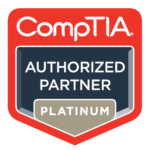CompTIA DataSys+
CompTIA DataSys+ provides a comprehensive set of resources for learning and skills validation to ensure that data management professionals have the skills needed to do the job securely, accurately and efficiently. It covers what database administrators need to deploy, manage and maintain systems, including employing the fundamentals of scripting and programming in a database environment while using security and business continuity best practices.
Covered skills include:
- Designing and modeling databases to meet a specific organizational need
- Executing database tasks, including processing and structuring data files, running routines, etc.
- Installing, configuring and maintaining database software and tools for optimal performance
- Establishing and maintaining sound security, backup and recovery policies and procedures
- Working with key stakeholders to translate data into actionable intelligence
AUDIENCE & Prerequisites
CompTIA DataSys+ is designed for those with 2-3 years of experience in a database administrator role. Other professionals, such as IT support specialists, software developers, network administrators, and database developer, are well-positioned to pursue a successful career as database administrators.
CompTIA DataSys+ is vendor-neutral, so the skills acquired are applicable regardless of the system that the organization is using. For this reason, the skills are also transferable should the organization migrate to a different technology or should the individual move on to a position at another organization.
The demand for capable database administrators is growing. Skilled database administrators are needed to oversee, maintain and protect the increasing quantity of data available to their organizations. As needs evolve and grow, CompTIA DataSys+ learning provides a uniform solution to develop talent from within.
Many people may call themselves database administrators or claim that they have the requisite capabilities, but organizations seeking to hire database administrators can rely on CompTIA DataSys+ certification to validate the skills of candidates.
Upon completing this course, students will be skilled at:
- Understanding database design and structure, including planning, implementation, testing and deployment
- Comparing and contrasting scripting methods and developing, modifying and running SQL code
- Explaining the impact of programming on database operations
- Monitoring and maintaining the data, reporting on and documenting any incidents
- Implementing critical data management tasks
- Securing the data by limiting access and defending against attacks
- Understanding and meeting regulation and governance requirements
- Creating and saving back-ups, and preparing for restoration/disaster recovery
Course Outline DataSys+ (DS0-001)
Lesson 1: Understanding Database Types and Structures
- Topic A: Identify Relational and Non- Relational Databases
- Topic B: Understand Different Types of NoSQL Databases and Tools
- Topic C: Understand Relational Database Design
- Topic D: Identify Other Data Systems
Lesson 2: Recognizing Standards and Commands
- Topic A: Understand Standards and Principles
- Topic B: Examine Operating Systems and Command Line Scripting
Lesson 3: Running Scripts for Data and Data Systems
- Topic A: Create and Alter Objects Using Data Definition Language
- Topic B: Manipulate Data using Data Manipulation Language
- Topic C: Work with Transactions
- Topic D: Perform Data Management Tasks
Lesson 4: Explaining the Impact of Programming on Database Operations
- Topic A: Work with Views
- Topic B: Understand Object Relational Mapping
- Topic C: Program with SQL
- Topic D: Write Functions
Lesson 5: Understanding Database Planning and Design
- Topic A: Understand Types of Architecture
- Topic B: Gather Data System Requirements
- Topic C: Review Documentation Requirements
Lesson 6: Implementing, Testing, and Deploying Databases
- Topic A: Prepare for Deployment
- Topic B: Conduct Testing and Other Quality Measures
- Topic C: Understand Validation Techniques and Methods
Lesson 7: Monitoring and Reporting on Database Performance
- Topic A: Consider Database Connectivity Needs
- Topic B: Monitor the Database
- Topic C: Understand and Address Deadlocks
Lesson 8: Understanding Common Data Maintenance Processes
- Topic A: Explain Patch Management
- Topic B: Ensure Database Performance
- Topic C: Ensure Database Integrity
Lesson 9: Understanding Governance and Regulatory Compliance
- Topic A: Understand the Importance of Protecting Data and Preventing Data Loss
- Topic B: Understand Data Retention Policies
- Topic C: Classify Data
- Topic D: Consider Global Jurisdiction and Regional Regulations
- Topic E: Understand Third-Party Agreements and Release Approvals
Lesson 10: Securing Data
- Topic A: Understand Data Encryption
- Topic B: Understand Data Masking
- Topic C: Describe Data Destruction Techniques
- Topic D: Audit Data Access
- Topic E: Audit Code and Changes
Lesson 11: Securing Data Access
- Topic A: Understand Identity and Access Management
- Topic B: Understand Access Controls
- Topic C: Understand Password Policies
- Topic D: Work with Service Accounts
Lesson 12: Securing the Database and Server
- Topic A: Utilize Physical Security
- Topic B: Utilize Logical Security
Lesson 13: Classifying Types of Attacks
- Topic A: Mitigate the SQL Injection Attack
- Topic B: Mitigate the Denial of Service (DoS) Attack
- Topic C: Mitigate the On-Path Attack
- Topic D: Mitigate the Brute Force Attack
- Topic E: Mitigate Social Engineering Attacks
- Topic F: Mitigate Malware
Lesson 14: Planning for Disaster Recovery
- Topic A: Plan for Disaster Recovery
- Topic B: Conduct DR Plan Testing
- Topic C: Transition/Failback to Normal Operations
Lesson 15: Implementing Backup and Restore Best Practices
- Topic A: Identify Types of Backups
- Topic B: Implement a Backup Strategy
- Topic C: Store and Purge Backups
Is there a discount available for current students?
UMBC students and alumni, as well as students who have previously taken a public training course with UMBC Training Centers are eligible for a 10% discount, capped at $250. Please provide a copy of your UMBC student ID or an unofficial transcript or the name of the UMBC Training Centers course you have completed. Asynchronous courses are excluded from this offer.
What is the cancellation and refund policy?
Student will receive a refund of paid registration fees only if UMBC Training Centers receives a notice of cancellation at least 10 business days prior to the class start date for classes or the exam date for exams.

